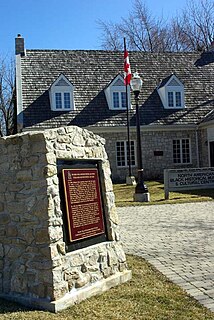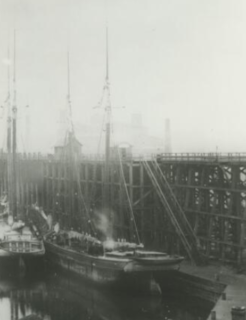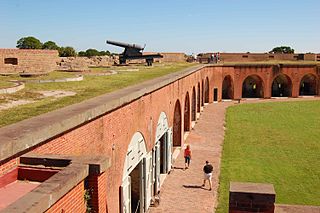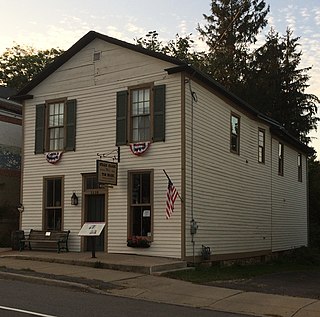 W
WAlum Creek is 58-mile (93 km) long creek that runs north to south in central Ohio. The creek originates in Morrow County and then flows through Delaware County and finally into Franklin County, where it ends at Big Walnut Creek, which drains into the Scioto River. Alum Creek is a source of drinking water for the city of Westerville, Ohio.
 W
WAmherstburg Freedom Museum, previously known as 'the North American Black Historical Museum', is located in Amherstburg, Ontario, Canada. It is a community-based, non-profit museum that tells the story of African-Canadians' history and contributions. Founded in 1975 by local residents, it preserves and presents artifacts of African-Canadians, many of whose ancestors had entered Canada as refugees from United States slavery. They found it relatively easy to enter Canada from across the Detroit River.
 W
WBarker General Store is a historic general store located at Beecher Hollow in Saratoga County, New York. The main block was constructed in 1847 and is a 2 1⁄2-story, gable-roofed rectangular building. A 2-story, shed-roofed addition was added in 1870. It features a tall portico supported by four Tuscan order turned wood columns. It is an example of transitional Federal / Greek Revival commercial architecture. A concealed area is believed to have served as a hiding place for escaped slaves being transported on the Underground Railroad.
 W
WThe Bialystoker Synagogue at 7–11 Bialystoker Place, formerly Willett Street, between Grand and Broome Streets in the Lower East Side neighborhood of Manhattan, New York City is an Orthodox Jewish synagogue. The building was constructed in 1826 as the Willett Street Methodist Episcopal Church; the synagogue purchased the building in 1905.
 W
WBroderick Park is a park situated along the Niagara River in Buffalo, New York, United States.
 W
WJohn Brown Tannery Site, 17620 John Brown Rd., Guys Mills, PA 16327, is a historic archaeological site located at Richmond Township, Crawford County, Pennsylvania. The tannery was built in 1825 by famed abolitionist John Brown (1800–1859), who lived on the site from 1825 to 1835. It was a major stop on the Underground Railway; Brown helped some 2,500 slaves during this period. The site includes the ruins of the tannery, a one-story, rectangular structure measuring 55 feet by 22 feet. There was a hidden room for the fugitive slaves. A fire destroyed the building in 1907. It is open to the public as the John Brown Farm, Tannery & Museum.
 W
WThe Buxton National Historic Site and Museum is a tribute to the Elgin Settlement, established in 1849 by Rev. William King and an association which included Lord Elgin, then the Governor General of Canada. King, a former slave owner turned abolitionist, purchased 9,000 acres (36 km2) of crown land in Southwestern Ontario and created a haven for fugitive slaves and free Blacks.
 W
WThe Capitol Park Historic District is a historic district located in downtown Detroit, Michigan. It is roughly bounded by Grand River, Woodward and Michigan Avenues, and Washington Boulevard. The district was listed on the National Register of Historic Places in 1999.
 W
WChristiana is a borough in Lancaster County, Pennsylvania, United States. The population was 1,168 at the 2010 census. In 1851 it was the site of the Battle of Christiana.
 W
WThe Dismal Swamp Canal is located along the eastern edge of the Great Dismal Swamp in Virginia and North Carolina in the United States. It is the oldest continually operating man-made canal in the United States, opened in 1805. It is part of the Intracoastal Waterway.
 W
WDunkirk Schooner Site is a historic shipwreck archaeological site located in Lake Erie off Dunkirk in Chautauqua County, New York. It lies about 20 miles (32 km) off Dunkirk resting in 170 feet (52 m) of cold freshwater, embedded on submerged lands of New York in the eastern basin of Lake Erie.
 W
WFort Pulaski National Monument is located on Cockspur Island between Savannah and Tybee Island, Georgia. It preserves Fort Pulaski; during the American Civil War, the Union Army successfully tested rifled cannon in combat in 1862 there, the success of which rendered brick fortifications obsolete. The fort was also used as a prisoner-of-war camp.
 W
WThe Graue Mill is a water-powered grist mill that was originally erected in 1852. Now a museum, it is one of two operating water-powered gristmills in Illinois. It is located on Salt Creek in Oak Brook, Illinois, owned by the Forest Preserve District of DuPage County and operated by a nonprofit preservationist group.
 W
WThe Great Dismal Swamp is a large swamp in the Coastal Plain Region of southeastern Virginia and northeastern North Carolina, between Norfolk, Virginia, and Elizabeth City, North Carolina. It is located in parts of the southern Virginia independent cities of Chesapeake and Suffolk and northern North Carolina counties of Gates, Pasquotank, and Camden. Some estimates place the size of the original swamp at over one million acres (4,000 km2).
 W
WHarriet Tubman Underground Railroad National Historical Park is a 480-acre (190 ha) National Park Service unit in the U.S. state of Maryland. It commemorates the life of former slave Harriet Tubman, who became an activist in the Underground Railroad prior to the American Civil War. The Harriet Tubman Underground Railroad National Monument was created by President Barack Obama under the Antiquities Act on March 25, 2013. The portion of the monument administered by the National Park Service was later designated a National Historical Park in 2014, and the remainder is managed by the Fish and Wildlife Service as part of Blackwater National Wildlife Refuge.
 W
WHarriet Tubman Underground Railroad State Park is a Maryland state park dedicated to the life and work of abolitionist and Underground Railroad activist Harriet Tubman. The park is on Route 335 near Church Creek in Dorchester County, adjacent to Blackwater National Wildlife Refuge.
 W
WLewis Hayden was an African-American leader who escaped with his family from slavery in Kentucky; they moved as refugees to Boston, Massachusetts. There he became an abolitionist, lecturer, businessman, and politician. Before the American Civil War, he and his wife Harriet Hayden aided numerous fugitive slaves on the Underground Railroad, often sheltering them at their house.
 W
WInglenook Community High School is a Toronto public high school which offers grade 10, 11, and 12 level courses. It is housed in an historical building designed by William George Storm in Corktown, in downtown Toronto, Ontario. The school has, on average, one hundred students and six teachers. It is located in the oldest continually-operated school building of the Toronto District School Board.
 W
WJohnston's Tavern, also known as the New Lodge Inn, is a historic inn and tavern located at Springfield Township, Mercer County, Pennsylvania. It was built in 1831, and is a two-story, five bay wide fieldstone building with Greek Revival style design details. It was one of the main stagecoach stops on the Pittsburgh-Erie Turnpike. The tavern was a stop on the Underground Railroad.
 W
WLewis and Harriet Hayden House was the home of African-American abolitionists who had escaped from slavery in Kentucky; it is located in Beacon Hill, Boston. They maintained the home as a stop on the Underground Railroad, and the Haydens were visited by Harriet Beecher Stowe as research for her book, Uncle Tom's Cabin (1852). Lewis Hayden was an important leader in the African-American community of Boston; in addition, he lectured as an abolitionist and was a member of the Boston Vigilance Committee, which resisted the Fugitive Slave Act of 1850.
 W
WMain Hall is an academic building on the campus of Lawrence University in Appleton, Wisconsin. Constructed in 1853, it was listed on the National Register of Historic Places in 1974.
 W
WSamuel Joseph May was an American reformer during the nineteenth century, and championed multiple reform movements including education, women's rights, and abolition of slavery. May argued on behalf of all working people that the rights of humanity were more important than the rights of property, and advocated for minimum wages and legal limitations on the amassing of wealth.
 W
WMortonson-Van Leer Log Cabin, is an historic cabin and one of the last historical dwellings in Swedesboro, Gloucester County, New Jersey, United States. It stands on the grounds of the cemetery of the Trinity Church. It is one of the oldest original log cabins of early Swedish-Finnish architecture in the United States.
 W
WNational Hotel is a historic hotel located at Cuylerville in Livingston County, New York. It is a large 2-story, seven-by-three-bay Federal / Greek Revival–style frame structure. It was built in 1841 and was reputedly a station on the Underground Railroad.
 W
WThe Battle of Negro Fort was a brief and destructive siege of a fortification filled with fugitive slaves, free blacks, and Choctaw by the United States and their Creek allies. On Prospect Bluff, overlooking the Apalachicola River, a settlement and fortification that Andrew Jackson and other white Americans labeled Negro Fort existed for a brief period. It was built by the British in 1814, during the War of 1812, in a remote part of what was at the time Spanish Florida. It is part of the Prospect Bluff Historic Sites, in the Apalachicola National Forest, Franklin County, Florida. The term "Negro Fort" was coined by the Americans only after the British Army had departed Florida in the aftermath of the Treaty of Ghent in 1815; its later residents were primarily blacks, either being free Negroes or fugitive slaves, residing together with some Choctaws. There were a significant number of fugitive slaves already in the area before the fort was built, and beginning in 1804 there was for several years a trading post operating in the settlement. The blacks, having been slaves that worked on plantation, knew how to plant and care for crops, and also to care for domesticated animals, mostly cattle.
 W
WThe Oneida Institute was a short-lived (1827–1843) but highly influential school that was a national leader in the emerging abolitionism movement. It was the most radical school in the country, the first at which black men were just as welcome as whites. "Oneida was the seed of Lane Theological Seminary, Western Reserve College, Oberlin and Knox colleges."
 W
WParsonsfield Seminary, which operated from 1832–1949, was a well-known Free Will Baptist school in North Parsonsfield, Maine, in the United States. Also known as the North Parsonsfield Seminary, its preserved campus of four buildings is located on State Route 160 near the New Hampshire border. The property is listed on the National Register of Historic Places.
 W
WThe Samuel Pleasants Parsons House is a historic dwelling located at 601 Spring Street in Richmond, Virginia. It is best known for being the home of quaker, abolitionist, and prison superintendent Samuel Pleasants Parsons. It is likely that this house was once a stop on the Underground Railroad. It is the oldest remaining building within the Oregon Hill neighborhood.
 W
WScollay Square was a vibrant city square in downtown Boston, Massachusetts. It was named for William Scollay, a prominent local developer and militia officer who bought a landmark four-story merchant building at the intersection of Cambridge and Court Streets in 1795. Local citizens began to refer to the intersection as Scollay's Square, and, in 1838, the city officially memorialized the intersection as Scollay Square. Early on, the area was a busy center of commerce, including daguerreotypist (photographer) Josiah Johnson Hawes (1808–1901) and Dr. William Thomas Green Morton, the first dentist to use ether as an anaesthetic.
 W
WThe Slippery Noodle Inn is a large blues bar and restaurant with two performance stages in downtown Indianapolis, Indiana. It also has the distinction of being the oldest continuously operating bar in the state of Indiana, having opened in 1850 as the Tremont House.
 W
WAbiel Smith School, founded in 1835, is a school located at 46 Joy Street in Boston, Massachusetts, United States, adjacent to the African Meeting House. It is named for Abiel Smith, a white philanthropist who left money in his will to the city of Boston for the education of black children.
 W
WStarr Clark Tin Shop is a historic commercial building located at Mexico in Oswego County, New York. It is a two-story wood-framed vernacular building built about 1827 with Federal details. The tin shop measures 24 feet 4 inches (7.42 m) wide and 32 feet (9.8 m) deep, with a 24-foot-4-inch-wide by 25-foot-8-inch-deep rear wing. Its owner, Starr Clark, was a widely recognized abolitionist and supporter of the Underground Railroad.
 W
WAsa and Caroline Wing House is a historic home located at Mexico in Oswego County, New York. It was probably built in the 1830s and is a 1 1⁄2-story frame settlement period structure. It has a fieldstone foundation, post and beam construction, plank walls, and gable roof. Asa and Caroline Wing purchased the home in 1847. It is a well-documented location used in harboring fugitive slaves. Specifically, from December 24–27, 1850, Asa Wing harbored seven members of the Thompson family in their flight to Canada.